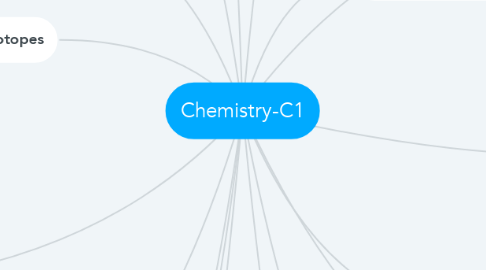Chemistry-C1
by Style by Samantha

1. State symbols
1.1. S= solid
1.2. L= liquid
1.3. aq= aqueous
1.4. G=gas
1.5. [Tip- remember it as SLAG]
2. Separation Techniques
2.1. insoluble solid and liquid= filtration
2.2. soluble substance and a liquid= evaporation
2.3. two liquids= distillation ( separation by boiling points
2.4. two soluble substances= chromatography
3. Separation Techniques
3.1. separating substances from a variety of mixtures
3.2. separation is a physical process not a chemical reaction
4. Nuclear model
4.1. - small positive nucleus
4.2. - electrons around the outside
5. Bohr
5.1. electrons are found on different energy levels ( now called electron shells)
6. Isotopes
6.1. isotopes are the same element but with different masses
6.2. isotopes have different masses because they have different numbers of nuetrons
7. Patterns of ion formations
7.1. group 1= I electron lost
7.2. group 2= 2 electrons lost
7.3. group 3=3 electrons lost
7.4. group 4=doesn't bond
7.5. group 5= 3 electrons gained
7.6. group 6=2 electrons gained
7.7. group 7=I electron gained
7.8. group 8=doesn't react because it has a full shell
7.9. every ion has a full outer shell and is stabel
8. Dobereiner
8.1. created triads of elements with similar properties
8.2. he created groups
9. Mendeleev
9.1. Arranged by atomic mass in groups of similar properties
9.2. He left gaps for elements not yet discovered
9.3. he predicted their properties and was proven right
9.4. he switched properties around so they were in the same groups as those with similar properties
9.5. these inconsistences occur because elements have different isotopes with different numbers of neutrons
10. Vocab
10.1. elements- are chemically pure, only one type of atom is present
10.2. compounds- are 2 or more elements that are chemically bonded
10.3. mixtures- are any combination of elements or compounds in the same volume
10.4. molecules- are 2 or more atoms which are chemically joined
11. Conservation of mass
11.1. in all chemical reactions the starting mass must equal the final mass
11.2. no atoms can be created or destroyed
11.3. if a gas is lost, the mass will appear to decrease
12. Plum pudding model
12.1. even positive charge
12.2. negative charges imbedded
12.3. no empty space
12.4. no overall charge
13. Rutherfords gold foil experimen
13.1. - almost all positives articles pass
13.2. - some positive particles are deflected by the positive nucleus
13.3. - the positive part of the atom must be tiny
14. Chadwick
14.1. discovered neutrons
14.2. mass number - atomic number = number of neutons
14.3. atom radius = 0.1nm (1x10^-10m)
14.4. nucleus radius = 1/10000 of the atom (1x10^-4)
15. Ionic bonding
15.1. an "ion" is a charged atom ( + or -)
15.2. definition of a metal- an element that forms a positive ion
15.3. non metal- an element that forms a negative ion
16. Combining powers
16.1. all compounds have no overall charge
17. Newlands
17.1. noticed that similar properties occur periodically
17.2. the idea of periods


